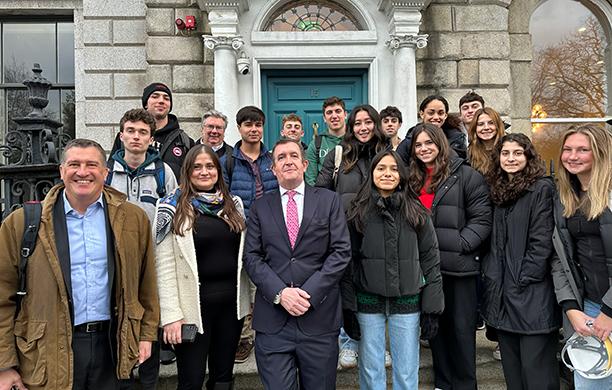Do you have a family member who came to America through Ellis Island? The iconic port of entry in the New York Harbor holds a special place in the hearts of many Americans. From 1892 to 1954, it served as the primary gateway for immigrants arriving in the United States. During this time, over 12 million immigrants, hailing from all corners of the world, were processed through its historic halls. For countless families, Ellis Island represents the starting point of their American journey, where hopes and dreams met with the promise of a new beginning.
That was certainly true for the family of late automotive industry titan Lee Iacocca ’45. His parents, Nicola and Antonietta, came through Ellis Island from San Marco dei Cavoti, Italy, in 1921. They started a successful family restaurant in Allentown, lost everything in the Great Depression, and then started over.
“My father and grandparents had grit and a tremendous work ethic — they never gave up,” says Iacocca’s daughter, Kate Hentz. “They knew it was a privilege to be in this country, to be able to have the opportunity.”
An American Success Story
Iacocca graduated from Lehigh with a degree in industrial engineering but realized after a brief stint in the field at Ford Motor Company that he preferred sales and marketing. He eventually became company president at Ford. After 32 years at Ford, Iacocca turned his transformative leadership skills to saving Chrysler when it was teetering on the verge of going out of business. Iacocca was soon called upon to use those skills to save Ellis Island and the Statue of Liberty.
Despite their historical significance, by the mid-20th century, the iconic landmarks had fallen into disrepair. Ellis Island’s buildings stood abandoned, facing the threat of demolition.
In the early 1980s, the future of Ellis Island hung in the balance. Many feared that this symbol of America's immigrant past would be lost forever.
Saving Ellis Island
In 1982, Iacocca took on a new challenge from President Ronald Reagan as the chairman of the Statue of Liberty-Ellis Island Foundation, a nonprofit formed to raise funds for the restoration of these national landmarks. Iacocca’s involvement was instrumental in rallying support and generating public interest in the cause. With his charisma and persuasive abilities, Iacocca embarked on a nationwide fundraising campaign, appealing to Americans' sense of pride and heritage.
Under Iacocca's leadership, the foundation launched the "Save Ellis Island" campaign, aiming to raise $156 million for the restoration of the island's buildings and infrastructure. Through strategies such as direct mail appeals, corporate sponsorships, and celebrity endorsements, Iacocca and his team exceeded their fundraising goals. They mobilized ordinary citizens and prominent figures alike to contribute to the preservation of this vital piece of American history.
Beyond his fundraising efforts, Iacocca played a hands-on role in the restoration process. He worked closely with architects, historians, and preservationists to ensure that Ellis Island would be restored to its former glory, accurately reflecting its immigrant past. His vision was not just to create a museum but to evoke the spirit of hope and resilience that characterized the immigrant experience.
In 1990, Ellis Island reopened to the public as the Ellis Island Immigration Museum, a testament to Iacocca's dedication and vision. Today, millions of visitors from around the world walk through its halls each year, retracing the footsteps of their ancestors and gaining a deeper understanding of America's rich cultural tapestry.
''If Miss Liberty was a symbol of hope, Ellis Island was a symbol of reality. We need both of these symbols because our country is not based on hope alone but on sweat and pain.''
Ellis Island’s Importance
“While my father was proud of his accomplishments in business, even more important to him was the difference he made in people’s lives,” Hentz recalls. “He told me the biggest thing he ever did in his life was restoring the Statue of Liberty and Ellis Island. That was just so profound for him, being the son of parents who were immigrants.”
Lee Iacocca's involvement in the restoration of Ellis Island serves as a reminder of the power of individuals to make a difference. His leadership transcended the business world, demonstrating a commitment to preserving heritage and fostering national pride. Through his efforts, Iacocca ensured that Ellis Island would continue to stand as a symbol of America's immigrant heritage for generations to come, securing his place in history as not only a corporate titan but also a guardian of American identity.
At an event held at the base of the Statue of Liberty in 1985, Iacocca said, ”If Miss Liberty was a symbol of hope, Ellis Island was a symbol of reality. We need both of these symbols because our country is not based on hope alone but on sweat and pain.”
Lee Iacocca led the fundraising effort to acquire the Mountaintop Campus from Bethlehem Steel in the 1980s. Simultaneously, he started the Iacocca Institute, which offers intercultural learning experiences to develop and challenge the next generation of global leaders. In honor of his contributions, Lehigh established four Iacocca chairs in 1991, one in each of the colleges at the time, as well as the Iacocca Scholarship. In 2011, he established the Iacocca International Internship Program, which funds real-world global work-abroad opportunities to enrich the student experience. In 2021, the Iacocca Family Foundation made a $5 million gift to continue his legacy by endowing the Iacocca Institute.


